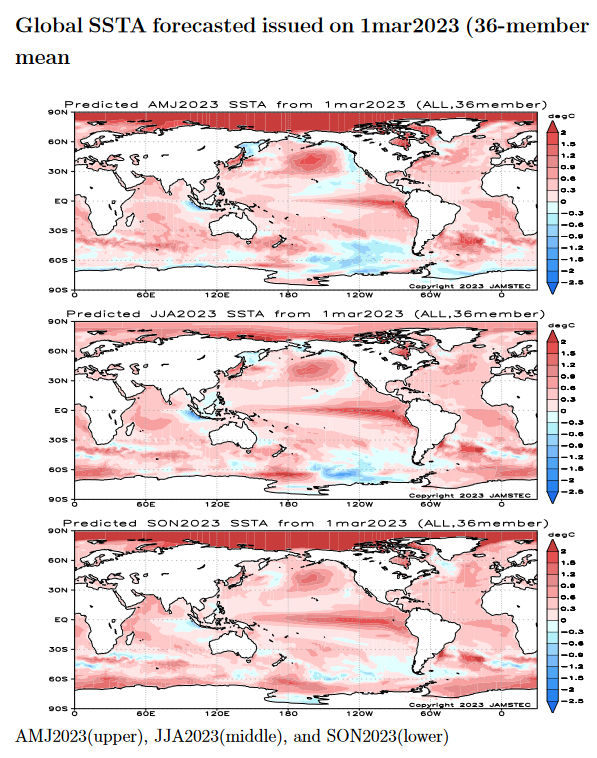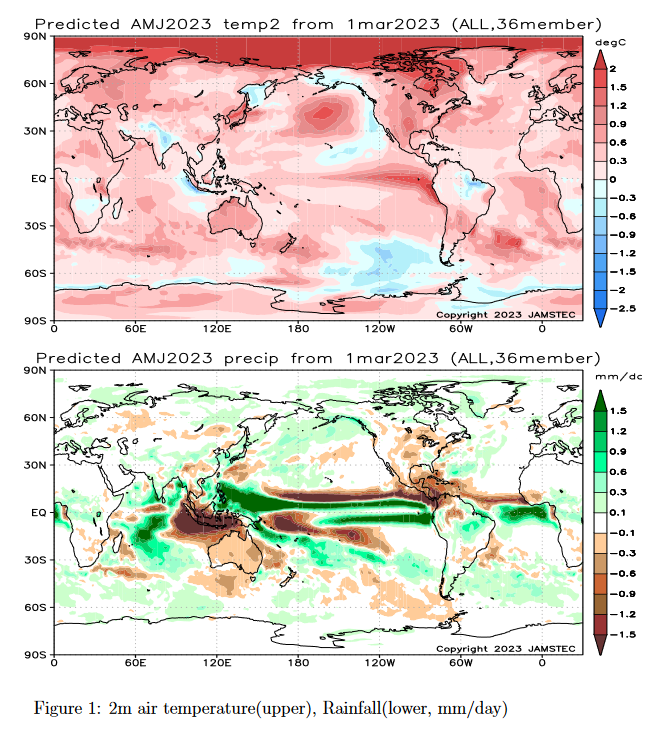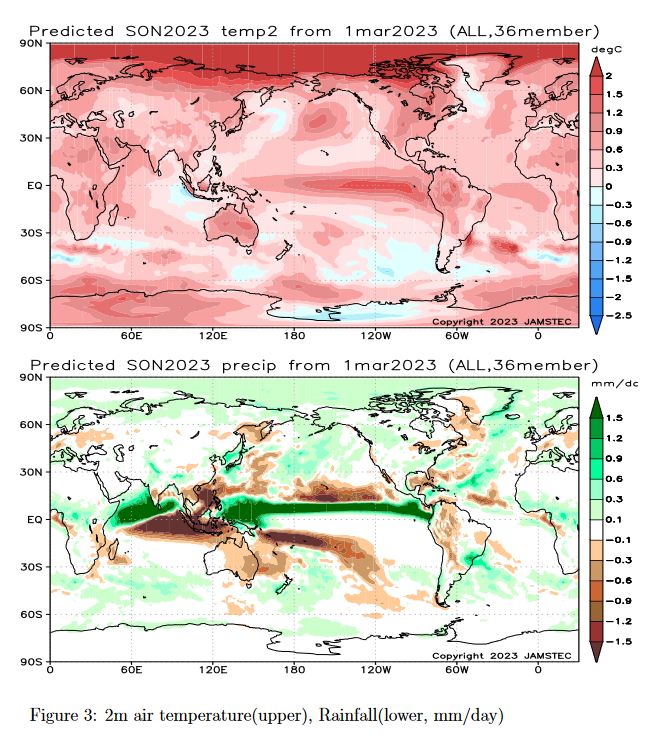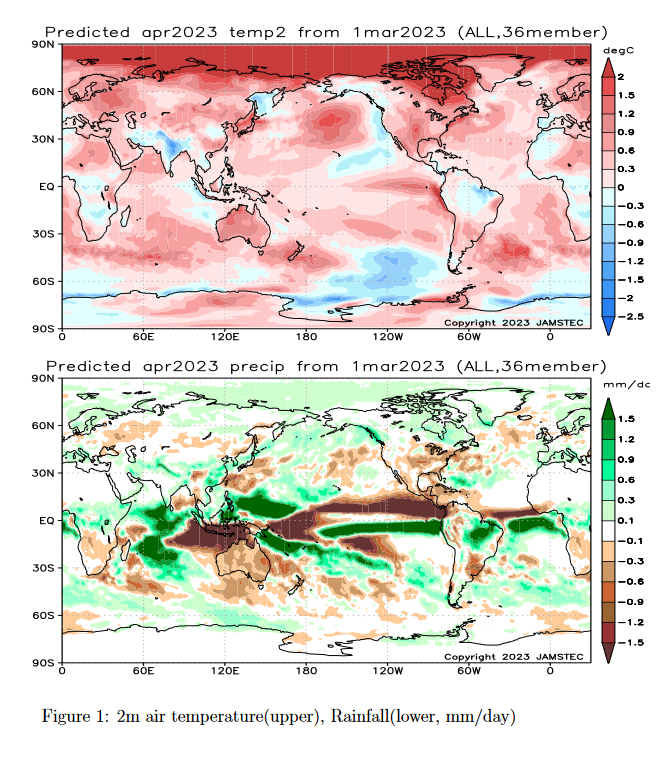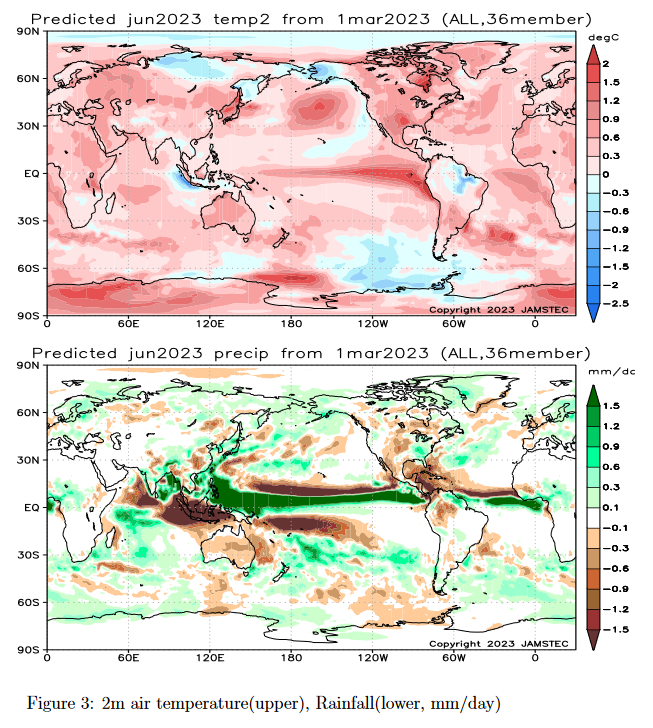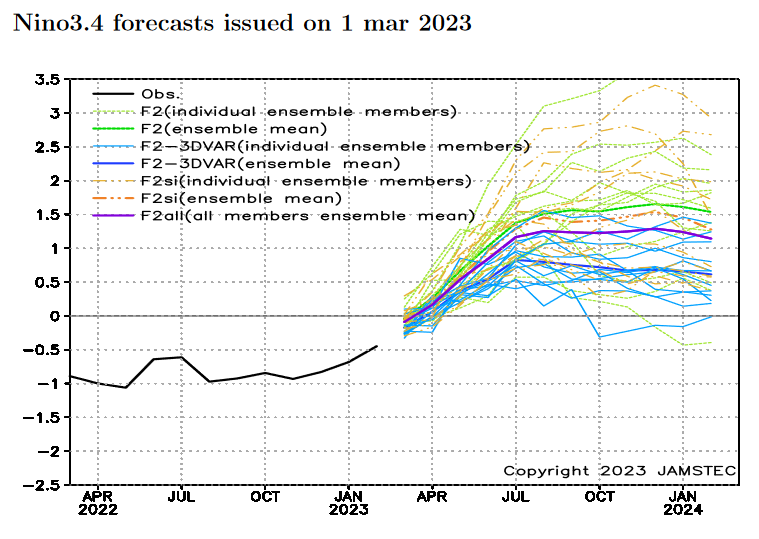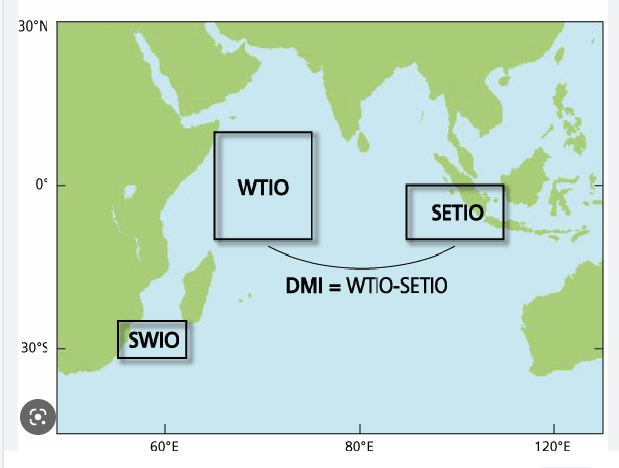Updated at 6:53 p.m. EDT March 24, 2023 to provide additional information on the Indian Ocean Dipole (IOD)
The Japan Agency for Marine-Earth Science and Technology, or JAMSTEC, is a Japanese national research institute for marine-earth science and technology
From the JAMSTEC Discussion:
Observation shows that the La Niña decayed and a La Niña Modoki-like state has appeared. The SINTEX-F ensemble mean predicts that an El Niño will occur in May. However, there is a large uncertainty in the predictions of the amplitude, and the ensemble mean of the SINTEX-F2-3DVAR version predicts a relatively weak El Niño.
Although it is a World forecast, it includes a forecast for North America since North America is part of the World.

First, we take a look at the forecasted sea surface temperature anomalies (SSTA). JAMSTEC starts by forecasting the SSTA and Nino 3.4 Index on the first day of the month and from there it takes their models about two weeks to produce their seasonal forecast. I received it from JAMSTEC on March 20, 2023.
| This shows their forecast of sea surface temperatures at three points in time. Notice the water along the Equator in the Pacific. Blue is cool (as an anomaly) and is associated with La Nina. Red is warm and is associated with El Nino. You can see the El Nino in all three time periods. It seems to be stronger in the 2nd and 3rd time period which is not necessarily in agreement with the Nino 3.4 forecast that I have from JAMSTEC so I am not sure how to interpret that. |
Then we look at three seasonal forecasts. JAMSTEC works with meteorological seasons and this month it does not line up perfectly. They handle that by showing three maps: April-May-June, then June-July-August, then September-October-November. So the three maps cover an eight-month duration with a slight overlap between the first two maps. This works pretty well.
| The top map is the temperature forecast for April/May/June (AMJ) 2023. The bottom map is the corresponding precipitation forecast.
And here is the interpretation from JAMSTEC:
|
| This covers June/July/August (JJA 2023) which is meteorological Summer. Notice the slight overlap as JAMSTEC prefers to forecast meteorological seasons.
Here is the interpretation from the JAMSTEC Discussion shown below:
|
| And above, September/October/November (SON) 2023 which is meteorological Fall. JAMSTEC does not provide its interpretation of its third season but one can observe it on the maps. |
Now I am going to provide their single-month forecasts for April, May, and June.
| The above is the single month of April 2023 |
| The above is the single month of May 2023 |
| The above is the single month of June 2023 |
Now we look at the key indices used by JAMSTEC in making their forecast. Perhaps I should have presented these first.
| It goes above +0.5C in May which means El Nino at least from the perspective of Sea Surface Temperature Anomalies. The JAMSTEC discussion refers to this El Nino as mild. I am not sure that I see a Nino 3.4 value of +1.3C as being mild. But they see the blue line as being more likely and it is barely an El Nino. The range of forecasts among their various modes corresponds to uncertainty which they address in their discussion. |
Here is a good resource for information on the IOD. From this article:
Here is a more complete analysis. Among other things, it discusses the complex relationship between the IOD and the phases of ENSO which is still not well understood. Below is a map that shows how the IOD index which is called the DMI is measured. Source: JAMSTEC
|
And here is the short JAMSTEC Discussion
ENSO forecast:
Observation shows that the La Niña decayed and a La Niña Modoki-like state has appeared. The SINTEX-F ensemble mean predicts that an El Niño will occur in May. However, there is a large uncertainty in the predictions of the amplitude, and the ensemble mean of the SINTEX-F2-3DVAR version predicts a relatively weak El Niño.
Indian Ocean forecast:
A positive Indian Ocean Dipole event is predicted by the SINTEX-F ensemble mean for boreal summer. However, there is a large uncertainty in the predictions of the amplitude.
Regional forecast:
On a seasonal scale, the SINTEX-F predicts that most parts of the globe will experience a warmer-than-normal condition in April–June average, except for Alaska, western Canada, some parts of Brazil, some parts of India, and some parts of southern Africa. In boreal summer (austral winter), the model also predicts that almost all of the globe will experience a warmer-than-normal condition, except for Alaska, northern Canada, some parts of Brazil, and northern Russia.
As regards the seasonally averaged rainfall in April–June, a drier-than-normal condition is predicted for some parts of Canada and the U.S.A., Mexico, central America, the northern part of the South American Continent, La Plata, some parts of West Africa, Australia, Indonesia, Indochina, some parts of China, and some parts of Eurasia. In contrast, Alaska, some parts of Canada, most of Brazil, central Africa, some parts of Europe, some parts of Russia, most of India, northern China, South Korea, and the Philippines will experience a wetter-than-normal condition. In boreal summer (austral winter), a wetter-than-normal condition is predicted for some parts of the North American Continent, Venezuela, Guyana, La Plata, some parts of Indochina, India, West Africa, northern Europe, northern Russia, some parts of China, the Korean Peninsula, and the Philippines. In contrast, southern Canada, the central part of the U.S.A., Mexico, Latin America, Colombia, western Brazil, Australia, some parts of central Africa, some parts of Russia, the northern part of China, and Indonesia will experience a drier-than-normal condition. In particular, we notice that Indonesia and Australia may experience drier than normal conditions, owing to the positive Indian Ocean Dipole and El Niño.
The model predicts that most of Japan will be warmer and wetter than normal in April–June average. In summer, the model also predicts the persistence of a similar condition.
–
| I hope you found this article interesting and useful |
